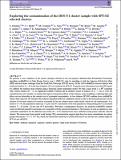Por favor, use este identificador para citar o enlazar a este item:
http://hdl.handle.net/10261/256655COMPARTIR / EXPORTAR:
 SHARE SHARE
 CORE
BASE CORE
BASE
|
|
| Visualizar otros formatos: MARC | Dublin Core | RDF | ORE | MODS | METS | DIDL | DATACITE | |

| Título: | Exploring the contamination of the DES-Y1 cluster sample with SPT-SZ selected clusters |
Autor: | Grandis, S.; Castander, Francisco J. CSIC ORCID; Fosalba, Pablo CSIC ORCID; García-Bellido, Juan CSIC ORCID; Gaztañaga, Enrique CSIC ORCID; Serrano, Santiago CSIC ORCID ; Wu, H.; DES Collaboration | Palabras clave: | Methods: statistical Galaxies: clusters: general Large-scale structure of the universe |
Fecha de publicación: | 25-mar-2021 | Editor: | Oxford University Press | Citación: | Monthly Notices of the Royal Astronomical Society 504(1): 1253-1272 (2021) | Resumen: | We perform a cross validation of the cluster catalogue selected by the red-sequence Matched-filter Probabilistic Percolation algorithm (redMaPPer) in Dark Energy Survey year 1 (DES-Y1) data by matching it with the Sunyaev-Zel'dovich effect (SZE) selected cluster catalogue from the South Pole Telescope SPT-SZ survey. Of the 1005 redMaPPer selected clusters with measured richness $\hat{\lambda }\gt 40$ in the joint footprint, 207 are confirmed by SPT-SZ. Using the mass information from the SZE signal, we calibrate the richness-mass relation using a Bayesian cluster population model. We find a mass trend λ ∝ MB consistent with a linear relation (B ∼1), no significant redshift evolution and an intrinsic scatter in richness of σλ = 0.22 ± 0.06. By considering two error models, we explore the impact of projection effects on the richness-mass modelling, confirming that such effects are not detectable at the current level of systematic uncertainties. At low richness SPT-SZ confirms fewer redMaPPer clusters than expected. We interpret this richness dependent deficit in confirmed systems as due to the increased presence at low richness of low-mass objects not correctly accounted for by our richness-mass scatter model, which we call contaminants. At a richness $\hat{\lambda }=40$, this population makes up ${\gt}12{{\ \rm per\ cent}}$ (97.5 percentile) of the total population. Extrapolating this to a measured richness $\hat{\lambda }=20$ yields ${\gt}22{{\ \rm per\ cent}}$ (97.5 percentile). With these contamination fractions, the predicted redMaPPer number counts in different plausible cosmologies are compatible with the measured abundance. The presence of such a population is also a plausible explanation for the different mass trends (B ∼0.75) obtained from mass calibration using purely optically selected clusters. The mean mass from stacked weak lensing (WL) measurements suggests that these low-mass contaminants are galaxy groups with masses ∼3-5 × 1013 M⊙ which are beyond the sensitivity of current SZE and X-ray surveys but a natural target for SPT-3G and eROSITA. | Descripción: | Grandis, S., et al. (DES Colaboration) | Versión del editor: | http://doi.org/10.1093/mnras/stab869 | URI: | http://hdl.handle.net/10261/256655 | DOI: | 10.1093/mnras/stab869 | Identificadores: | doi: 10.1093/mnras/stab869 issn: 1365-2966 |
| Aparece en las colecciones: | (ICE) Artículos |
Ficheros en este ítem:
| Fichero | Descripción | Tamaño | Formato | |
|---|---|---|---|---|
| Exploring_the_contamination_of_the_DES_y1.pdf | 2,06 MB | Adobe PDF |  Visualizar/Abrir |
CORE Recommender
SCOPUSTM
Citations
12
checked on 22-mar-2024
WEB OF SCIENCETM
Citations
5
checked on 24-feb-2024
Page view(s)
29
checked on 18-abr-2024
Download(s)
64
checked on 18-abr-2024
Google ScholarTM
Check
Altmetric
Altmetric
NOTA: Los ítems de Digital.CSIC están protegidos por copyright, con todos los derechos reservados, a menos que se indique lo contrario.
